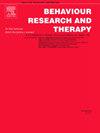在健康到临床社交焦虑的成人暴露治疗模拟过程中,威胁预测误差、预测改变和焦虑之间的关系
IF 4.2
2区 心理学
Q1 PSYCHOLOGY, CLINICAL
引用次数: 0
摘要
当代焦虑暴露治疗模型认为暴露必须产生威胁预测误差才能有效。需要更多的研究来在临床环境中验证这一说法。本研究探讨了在暴露模拟过程中威胁预测错误学习与结果的关系。成年心理学本科学生(N = 125)经历了各种各样的社交焦虑症状,从健康水平到临床水平的社交焦虑,完成了667次在线语音表现暴露,两次测试间隔一周(大约一周)。3演讲/会话)。每次暴露时测量自我报告的焦虑、威胁预测、威胁结果和惊讶,并用于推导学习指标。这些包括威胁预测误差、预测变化和预测误差转化为预测变化的程度(即学习率)。我们使用多层模型检查了这些学习指标与暴露结果之间的人际关系和人际关系。平均预测变化和预测错误学习率,而不是平均预测错误本身,与整个暴露过程中更多的焦虑减少有关。在个人内部,在暴露引发更多预测变化后,焦虑程度较低。威胁预测误差与下一次暴露时的焦虑不呈线性相关。在暴露过程中,更高的威胁预测误差与更大的主观惊讶有关。我们的结论是,暴露结果取决于患者将暴露相关的预测误差转化为威胁预测变化的程度。未来的研究应侧重于提高暴露预测错误学习率的策略。本文章由计算机程序翻译,如有差异,请以英文原文为准。
Associations among threat prediction error, prediction change, and anxiety during an exposure therapy analogue in adults with healthy to clinical social anxiety
Contemporary exposure therapy models for anxiety argue that exposures must generate threat prediction error to be effective. More research is needed to test this claim in clinical settings. This study explored how threat prediction error learning relates to outcomes during an exposure analogue procedure. Adult undergraduate psychology students (N = 125) experiencing a broad range of social anxiety symptoms from healthy to clinical levels of social anxiety completed 667 online speech performance exposures over two testing sessions separated by a week (approx. 3 speeches/session). Self-reported anxiety, threat prediction, threat outcome, and surprise were measured for each exposure and used to derive learning indicators. These included threat prediction error, prediction change, and the extent that prediction errors were converted to prediction change (i.e., learning rate). We examined between- and within-person relationships between these learning indicators and outcomes over exposure using multilevel modelling. Average prediction change and prediction error learning rate, but not average prediction error per se, was associated with more anxiety reduction across the exposure. Within-person, anxiety was lower after exposures that triggered more prediction change. Threat prediction error was not linearly associated with anxiety at the next exposure. Higher threat prediction error during an exposure was associated with greater subjective surprise for that exposure. We concluded that exposure outcomes depend on how much the patient converts exposure-related prediction errors into threat prediction change. Future research should focus on strategies to enhance the prediction-error learning rate from exposures.
求助全文
通过发布文献求助,成功后即可免费获取论文全文。
去求助
来源期刊

Behaviour Research and Therapy
PSYCHOLOGY, CLINICAL-
CiteScore
7.50
自引率
7.30%
发文量
148
期刊介绍:
The major focus of Behaviour Research and Therapy is an experimental psychopathology approach to understanding emotional and behavioral disorders and their prevention and treatment, using cognitive, behavioral, and psychophysiological (including neural) methods and models. This includes laboratory-based experimental studies with healthy, at risk and subclinical individuals that inform clinical application as well as studies with clinically severe samples. The following types of submissions are encouraged: theoretical reviews of mechanisms that contribute to psychopathology and that offer new treatment targets; tests of novel, mechanistically focused psychological interventions, especially ones that include theory-driven or experimentally-derived predictors, moderators and mediators; and innovations in dissemination and implementation of evidence-based practices into clinical practice in psychology and associated fields, especially those that target underlying mechanisms or focus on novel approaches to treatment delivery. In addition to traditional psychological disorders, the scope of the journal includes behavioural medicine (e.g., chronic pain). The journal will not consider manuscripts dealing primarily with measurement, psychometric analyses, and personality assessment.
 求助内容:
求助内容: 应助结果提醒方式:
应助结果提醒方式:


